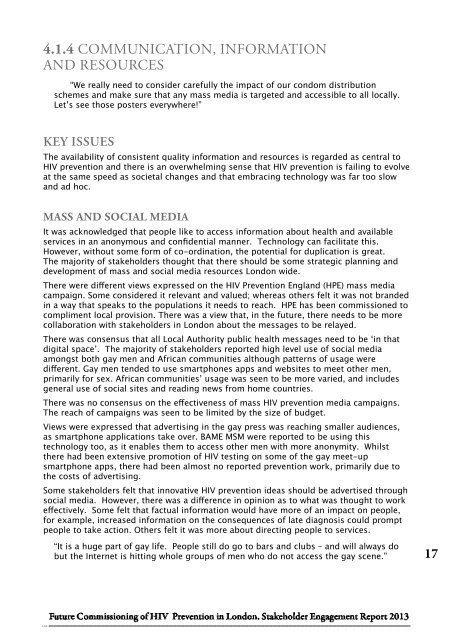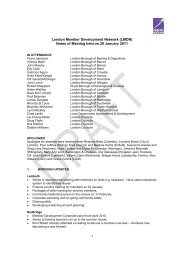Stakeholder Engagement Report - London Councils
Stakeholder Engagement Report - London Councils
Stakeholder Engagement Report - London Councils
Create successful ePaper yourself
Turn your PDF publications into a flip-book with our unique Google optimized e-Paper software.
4.1.4 Communication, information<br />
and resources<br />
“We really need to consider carefully the impact of our condom distribution<br />
schemes and make sure that any mass media is targeted and accessible to all locally.<br />
Let’s see those posters everywhere!”<br />
Key Issues<br />
The availability of consistent quality information and resources is regarded as central to<br />
HIV prevention and there is an overwhelming sense that HIV prevention is failing to evolve<br />
at the same speed as societal changes and that embracing technology was far too slow<br />
and ad hoc.<br />
Mass and social media<br />
It was acknowledged that people like to access information about health and available<br />
services in an anonymous and confidential manner. Technology can facilitate this.<br />
However, without some form of co-ordination, the potential for duplication is great.<br />
The majority of stakeholders thought that there should be some strategic planning and<br />
development of mass and social media resources <strong>London</strong> wide.<br />
There were different views expressed on the HIV Prevention England (HPE) mass media<br />
campaign. Some considered it relevant and valued; whereas others felt it was not branded<br />
in a way that speaks to the populations it needs to reach. HPE has been commissioned to<br />
compliment local provision. There was a view that, in the future, there needs to be more<br />
collaboration with stakeholders in <strong>London</strong> about the messages to be relayed.<br />
There was consensus that all Local Authority public health messages need to be ‘in that<br />
digital space’. The majority of stakeholders reported high level use of social media<br />
amongst both gay men and African communities although patterns of usage were<br />
different. Gay men tended to use smartphones apps and websites to meet other men,<br />
primarily for sex. African communities’ usage was seen to be more varied, and includes<br />
general use of social sites and reading news from home countries.<br />
There was no consensus on the effectiveness of mass HIV prevention media campaigns.<br />
The reach of campaigns was seen to be limited by the size of budget.<br />
Views were expressed that advertising in the gay press was reaching smaller audiences,<br />
as smartphone applications take over. BAME MSM were reported to be using this<br />
technology too, as it enables them to access other men with more anonymity. Whilst<br />
there had been extensive promotion of HIV testing on some of the gay meet-up<br />
smartphone apps, there had been almost no reported prevention work, primarily due to<br />
the costs of advertising.<br />
Some stakeholders felt that innovative HIV prevention ideas should be advertised through<br />
social media. However, there was a difference in opinion as to what was thought to work<br />
effectively. Some felt that factual information would have more of an impact on people,<br />
for example, increased information on the consequences of late diagnosis could prompt<br />
people to take action. Others felt it was more about directing people to services.<br />
“It is a huge part of gay life. People still do go to bars and clubs – and will always do<br />
but the Internet is hitting whole groups of men who do not access the gay scene.”<br />
17




